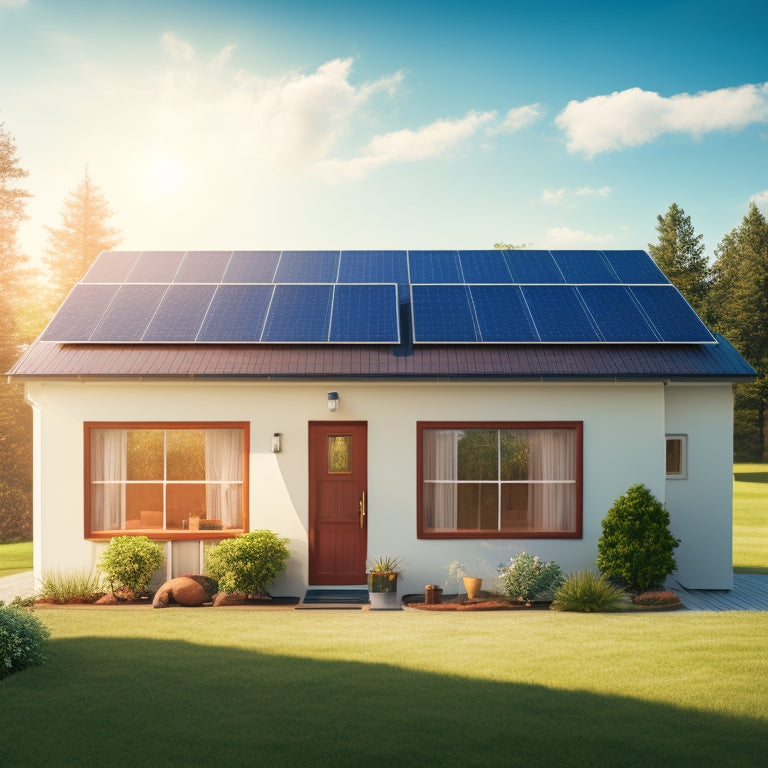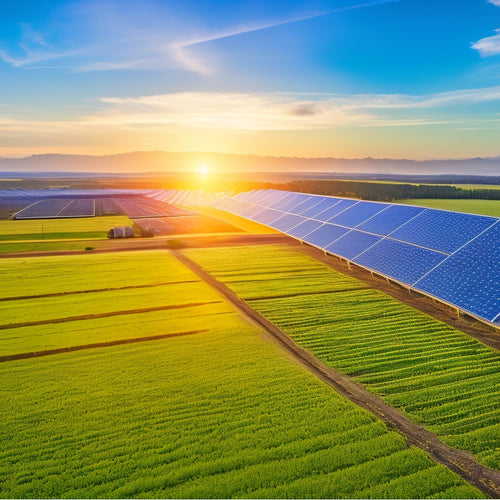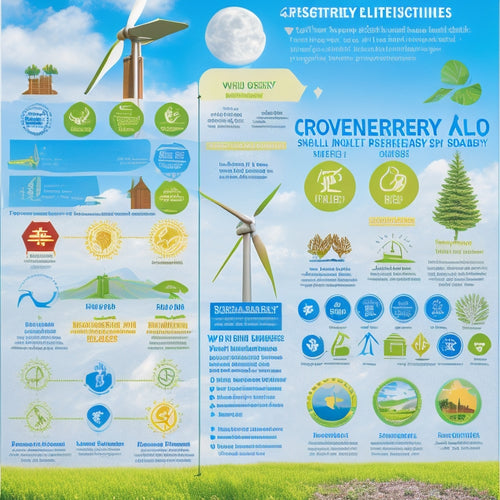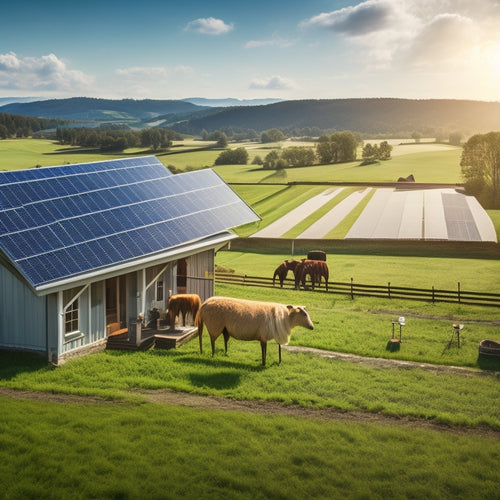
Essential Steps to Setting Up Solar System for Your House
Share
You'll start by evaluating your energy needs, reviewing past bills to determine your average daily consumption and identifying opportunities for efficiency improvements. Next, you'll choose the right equipment, selecting solar panels and inverters that match your needs and budget. Then, you'll prepare your roof, ensuring it's structurally sound and free from obstructions. After that, you'll install the panels, securely fastening them to maximize energy output. Finally, you'll connect to the grid, installing a grid tie inverter and net meter while ensuring a safe and permitted connection. Now that you've got the basics covered, you're ready to plunge deeper into the details that'll make your solar system shine.
Key Takeaways
- Assess your energy needs by reviewing past electricity bills and identifying high-energy-consuming appliances to determine optimal solar panel size.
- Choose the right equipment, including solar panel type and inverter, based on efficiency rates, costs, and compatibility with your energy needs.
- Prepare your roof structure by ensuring it's free from obstructions, structurally sound, and compliant with local building codes and regulations.
- Install solar panels properly by securely fastening them to the roof, angling and positioning for maximum energy output, and meeting local building codes.
- Connect to the grid safely by installing a grid tie inverter, net meter, and working with a licensed electrician to ensure a secure and compliant connection.
Assessing Your Energy Needs
Evaluating Your Energy Needs
Most households consume a significant amount of energy daily, and understanding your energy needs is vital in determining the right solar system for your house. You need to know how much energy you consume to size your solar system correctly. Start by reviewing your past electricity bills to determine your average daily energy consumption in kilowatt-hours (kWh). This will give you a clear overview of your energy usage patterns.
Take note of the appliances and devices that consume the most energy, such as refrigerators, air conditioners, and lighting systems.
To maximize solar efficiency, it's important to identify opportunities to reduce your energy consumption. Look for ways to improve energy efficiency, such as replacing incandescent bulbs with LED bulbs, using energy-efficient appliances, and turning off devices when not in use.
Choosing the Right Equipment
Now that you've determined your energy needs and identified opportunities to reduce consumption, it's time to focus on the equipment that will convert sunlight into usable electricity.
You'll need to select the right solar panel types and inverter options for your system. Solar panels come in various types, including monocrystalline, polycrystalline, and thin-film. Each has its own efficiency rates and costs.
Here's a comparison of some popular solar panel types:
| Type | Efficiency | Cost |
|---|---|---|
| Monocrystalline | 15-20% | High |
| Polycrystalline | 12-15% | Medium |
| Thin-Film | 7-14% | Low |
| Bifacial | 15-20% | High |
| PERC | 18-22% | High |
Inverters, on the other hand, convert DC power from the solar panels to AC power for your home. You can choose from string inverters, microinverters, or power optimizers. Consider factors like efficiency, compatibility, and warranty when selecting your inverter.
Preparing Your Roof Structure
With your equipment selection complete, your attention turns to the roof structure that will support your solar panel system.
You'll need to assess the roof's orientation, as south-facing roofs receive the most sunlight and are ideal for solar panels. Make sure the roof is free from obstructions like vents, skylights, or chimneys, which could cast shadows on the panels.
Next, evaluate the structural integrity of your roof to verify it can support the weight of the solar panels and withstand environmental stresses like wind and snow.
You may need to consult a structural engineer or roofing expert to assess the roof's condition and recommend any necessary repairs or reinforcements.
Additionally, check local building codes and regulations regarding roof modifications to guarantee compliance.
Installing Solar Panels Properly
Installing Solar Panels Properly
Proper installation is the linchpin of a successful solar panel system, as it directly impacts the system's energy output, durability, and overall safety. When it comes to installing your solar panels, you'll need to choose the right type of solar panel for your roof structure and local climate.
There are two primary solar panel types: monocrystalline and polycrystalline. Monocrystalline panels are more efficient but pricier, while polycrystalline panels are more affordable but less efficient.
Before you start installing, make certain you've obtained the necessary installation permits from your local authorities. This will guarantee that your system meets local building codes and regulations.
During installation, your solar panels should be securely fastened to your roof, considering factors like wind resistance and snow load. The panels should also be angled and positioned to maximize energy output, taking into account your roof's orientation and shading.
A well-installed system will provide you with clean, reliable energy for years to come.
Connecting to the Grid Safely
The electrical grid is a complex network that requires careful integration to secure safe and efficient energy distribution. When connecting your solar system to the grid, you must ascertain that you comply with safety regulations to avoid any potential risks.
To achieve a safe grid connection, you'll need to install a grid tie inverter, which synchronizes your solar system's output with the grid's frequency and voltage. This inverter will automatically shut down your system in case of a grid outage, preventing any potential backfeeding that could harm utility workers.
You'll also need to install a net meter, which measures the excess energy your system produces and feeds back into the grid.
It's essential to work with a licensed electrician who's experienced in solar installations to confirm that your system meets all safety regulations and grid connection requirements. They'll help you steer through the necessary permits and inspections, assuring a safe and efficient grid connection.
Frequently Asked Questions
Can I Install Solar Panels on a Metal or Tile Roof?
You can install solar panels on a metal or tile roof, but you'll need to take into account specific requirements. For metal roof installation, guarantee a secure attachment system, while tile roof factors involve avoiding damage to tiles and confirming waterproofing.
How Often Should I Clean My Solar Panels?
Savvy solar seekers, shine on! Clean your solar panels every 6-12 months to maintain peak energy output. Regular solar panel maintenance guarantees ideal performance, so schedule cleaning frequency according to your region's pollution and precipitation patterns.
Are Solar Panels Resistant to Hail and Extreme Weather?
You'll be relieved to know that solar panels are designed to withstand extreme weather conditions, including hail, thanks to their durable construction and rigorous testing, ensuring your power generation remains unaffected by Mother Nature's fury.
Can I Use Solar Energy to Power My Swimming Pool?
Are you tired of high electricity bills from running your pool pump? You can utilize solar energy to power your pool, and a solar pool system can provide significant energy savings, offsetting a substantial portion of your energy costs.
Do Solar Panels Generate Electricity During a Power Outage?
You're wondering if solar panels generate electricity during a power outage. Typically, they don't, since they're grid-tied and shut off for safety reasons. However, with off-grid systems and battery storage, you can continue to generate and store electricity, even when the grid is down.
Conclusion
"Seamlessly synchronizing solar collaboration, you've successfully shifted towards sustainable energy. By following these essential steps, your solar system is now efficiently energizing your home. From evaluating your energy appetite to connecting to the grid with care, each careful move has maximized your system's potential. Now, sit back, soak up the sun's savings, and savor the satisfaction of switching to a smarter, more sustainable solution."
Related Posts
-

Solar Power for Reducing Carbon Footprint
Solar power is an effective strategy for reducing your carbon footprint. By adopting solar energy, you can cut greenh...
-

Renewable Energy Certifications for Businesses
Renewable energy certifications are essential for your business, showcasing your commitment to sustainability and enh...
-

Solar Power Systems for Rural Properties
Solar power systems offer a reliable and efficient energy solution for rural properties, allowing you to gain energy ...


